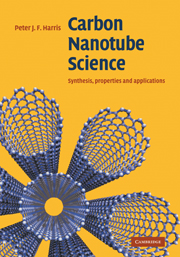Book contents
- Frontmatter
- Contents
- Preface
- 1 Introduction
- 2 Synthesis I: arc- and laser-vaporization, and heat treatment methods
- 3 Synthesis II: catalytic chemical vapour deposition and related methods
- 4 Purification and processing
- 5 Structure
- 6 Physical properties I: electronic
- 7 Physical properties II: mechanical, optical and thermal
- 8 Chemistry and biology of nanotubes
- 9 Carbon nanotube composites
- 10 Filled and heterogeneous nanotubes
- 11 Probes and sensors
- 12 Conclusions
- Name Index
- Subject Index
4 - Purification and processing
Published online by Cambridge University Press: 20 May 2010
- Frontmatter
- Contents
- Preface
- 1 Introduction
- 2 Synthesis I: arc- and laser-vaporization, and heat treatment methods
- 3 Synthesis II: catalytic chemical vapour deposition and related methods
- 4 Purification and processing
- 5 Structure
- 6 Physical properties I: electronic
- 7 Physical properties II: mechanical, optical and thermal
- 8 Chemistry and biology of nanotubes
- 9 Carbon nanotube composites
- 10 Filled and heterogeneous nanotubes
- 11 Probes and sensors
- 12 Conclusions
- Name Index
- Subject Index
Summary
None of the techniques discussed in the previous two chapters produce pure carbon nanotubes. When multiwalled nanotubes are produced by arc-evaporation, for example, they are always accompanied by nanoparticles and disordered carbon. When produced catalytically, nanotubes are contaminated with catalyst particles and support material. In order to make use of the nanotubes, therefore, it is often necessary to purify them. This chapter begins with a summary of the chemical and physical methods available for purifying nanotubes. Techniques for processing nanotubes are then reviewed. Procedures for aligning tubes and for forming them into fibres and sheets are covered, and methods for sorting them by length and structure outlined. Ways of improving the solubility of nanotubes by functionalization are covered later in the book (Chapter 8), while the incorporation of nanotubes into composite materials is discussed in Chapter 9.
Purification of multiwalled tubes
MWNTs produced by arc-evaporation
The first successful technique for purifying multiwalled tubes produced by arc-evaporation was described by Thomas Ebbesen and co-workers in 1994 (4.1). Following the demonstration that nanotube caps could be selectively attacked by oxidizing gases (see Chapter 10), these researchers realized that nanoparticles, with their defect-rich structures might be oxidized much more readily than the relatively perfect nanotubes. Therefore they subjected raw nanotube samples to a range of oxidizing treatments, in the hope that the nanoparticles would be preferentially oxidized away. They found that a significant relative enrichment of nanotubes could be achieved in this way, but only at the expense of losing of a major proportion of the original sample.
- Type
- Chapter
- Information
- Carbon Nanotube ScienceSynthesis, Properties and Applications, pp. 80 - 106Publisher: Cambridge University PressPrint publication year: 2009
- 1
- Cited by

